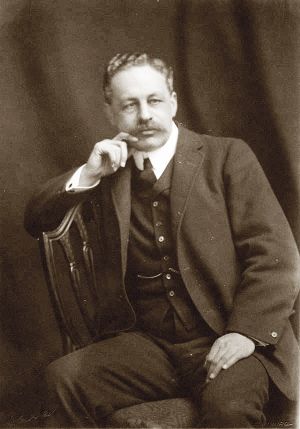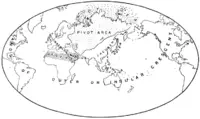Halford Mackinder
Halford John Mackinder (born February 15, 1861 – died March 6, 1947), was an English geographer and geopolitician, famous for his work as an educator and for his conception of the globe as divided into two parts – superior Eurasian “heartland” and the inferior rest of the world.
Life
Halford John Mackinder was born in Gainsborough, Lincolnshire, England, the eldest son of Draper and Fanny Anne Hewitt Mackinder, both of Scottish descent. He was educated at Queen Elizabeth's Grammar School, Gainsborough (now Queen Elizabeth's High School), after which he attended Christ Church, in Oxford, specializing to become a biologist. He received the highest honors in his class in 1883, and continued to study modern history. His interest gradually shifted toward geography, which at the time was not regarded as a single science, but was divided into physical and human geography.
After graduating from University of Oxford he went on applying for the bar and studying law in the Inner Temple. He became a barrister in 1886.
In 1887 Mackinder was appointed Reader in Geography at the University of Oxford, then by far the most senior position for a British geographer. He advocated that physical and human geography should be treated as a single discipline, and by 1899 he had drawn together a single School of Geography – the Oxford School of Geography. Mackinder became the first president of the school.
In 1895, he was one of the founders, together with Sydney and Beatrice Webb, of the London School of Economics. Mackinder was also a member of the Coefficients Dining Club, made of Fabian Society members, to whom Webbs belonged. In 1990 the school became a college of the University of London.
In 1899 Mackinder led the expedition to East Africa, and climbed Mt. Kenya.
Mackinder stayed at Oxford until 1904, when he accepted position of the director of the London School of Economics. He dedicated his energies completely to the administration and the leadership of the school. During that time he however continued his connection with geography, teaching classes in economic geography.
In 1910 Mackinder resigned his position at LSE to enter politics. He became a member of the Parliament in 1910, running as Unionist Party member for the Camlachie division of Glasgow. He was a strong supporter of British imperialistic policies. He was defeated in 1922. From 1913 to 1946 Mackinder was chairman, and in 1916 he was elected President of the Geographical Association.
In 1919 Mackinder was sent as British high commissioner to southern Russia, to try to unify White Russian forces against communists. Upon his return to Britain in 1920 he was knighted.
He served as chairman of the Imperial Shipping Committee from 1920 to 1945 and of the Imperial Economic Committee from 1926 to 1931. Among many honors he received were the Patron's Medal of the Royal Geographical Society (1946), and the Charles P. Daly Medal of the American Geographical Society (1943).
Mackinder died on March 6, 1947, in Parkstone, Dorset, England.
Work
In 1902 Mackinder published his famous Britain and The British Seas, which included the first comprehensive geomorphology of Great Britain. This work, together with his 1904 paper The Geographical Pivot of History formulated the Heartland Theory, which is often considered as a, if not the, founding moment of Geopolitics, as a field of study (although Mackinder did not use the term). Whilst the Heartland Theory initially receiving little attention outside geography, this theory would influence the foreign policies of world powers ever since.
Generally, Mackinder argued that interior Asia and Eastern Europe (the heartland) have strategic importance for the world. As the sea power declined in the 20th century, marking the end of the "Columbian epoch", the mainland and the land power become the strategic centre of the “World Island” (by “World Island”, he meant the Euro-Asian-African landmass). He believed that the railroads pawed the path for that new change. That is why he believed that the inner areas of the Eurasian continent, which were in the “heart” of the world, with easy accessibility to all the other regions of the world, would have the special geostrategic importance in the 20th century. Mackinder emphasized the role of Britain and the United States to preserve a balance between the powers trying to control the heartland.
Mackinder’s next major work was in 1919 - Democratic Ideals and Reality – which was a perspective on the 1904 work in the light of peace treaties of the World War I and Woodrow Wilson's idealism. This work contains his most famous quote:
- "Who rules East Europe commands the Heartland;
- Who rules the heartland commands the World Island;
- Who rules the World Island commands the World."
This message was composed for world statesmen at the Treaty of Versailles. Mackinder emphasized the need for the long-lasting peace, trying to find the way how to ensure geostrategic stability in Europe. He emphasized East Europe as the strategic route to the Heartland and proposed establishing a strip of buffer states to separate Germany and Russia. These buffers proved to be ineffective bulwarks in 1939. Mackinder was a convinced anti-Bolshevik. The principal concern of his work was to warn of the possibility of another major war, the one between Germany and communist Russia.
Mackinder’s ideas were in many ways prophetic, predicting that the chaos in a defeated Germany would lead to dictatorship. He also elaborated on the concept of the “one world”, and the need for establishment of regional powers. He proposed the theory of the Atlantic community, which became reality after World War II and the establishment of the North Atlantic Treaty Organization (NATO).
The Heartland Theory was enthusiastically taken up by the German school of Geopolitik, in particular by its main proponent Karl Haushofer. Whilst Geopolitik was later embraced by the German Nazi regime in the 1930s, Mackinder was always extremely critical of the German exploitation of his ideas.
Legacy
Mackinder's work paved the way for the establishment of geography as a distinct discipline in the United Kingdom. University of Oxford would not appoint a Chair until 1934, but the University of Liverpool and University of Wales both appointed Chairs in 1917. Mackinder was given a personal chair at the London School of Economics in 1923. His role in fostering the teaching of geography is probably greater than any single British geographer.
Mackinder is also credited with introducing two new terms into the dictionary: "manpower", and "heartland".
Publications
- Mackinder, Halford J. 1902. Britain and the British seas. New York: D. Appleton and Co.
- Mackinder, Halford J. 1906. Money-power and man-power: The underlying principles rather than the statistics of tariff reform. London: Simpkin.
- Mackinder, Halford J. 1914. The modern British state: An introduction to the study of civics. London: G. Philip.
- Mackinder, Halford J. 1921. Geography as a pivotal subject in education. Geographical Journal. 57(5), 376-384.
- Mackinder, Halford J. 1921. The nations of the modern world: An elementary study in geography and history. London: G. Philips & Son.
- Mackinder, Halford J. 1924. The world war and after: A concise narrative and some tentative ideas. London: G. Philip & Son, Ltd
- Mackinder, Halford J. 1981 (original published in 1919). Democratic Ideals and Reality. Greenwood Press Reprint. ISBN 0313231508
- Mackinder, Halford J. 1990. The first ascent of Mount Kenya (Edited by Kenneth Barbour). Athens, Ohio: Ohio University Press. ISBN 0821409875
- Mackinder, Halford J. 2004 (original published in 1904). The geographical pivot of history (1904). The Geographical Journal. 170(4), 298-321.
ReferencesISBN links support NWE through referral fees
- Blouet, Brian W. 1975. Sir Halford Mackinder, 1861-1947: Some new perspectives. Oxford: School of Geography, University of Oxford.
- Blouet, Brian W. 1987. Halford Mackinder: A biography. College Station: Texas A & M University Press. ISBN 0890962928
- Halford John Mackinder. Encyclopedia Britannica Concise at http://concise.britannica.com/. Retrieved on May 14, 2007, <http://concise.britannica.com/ebc/article-9049795/Halford-John-Mackinder>
- Semmel, Bernard. 1983. Imperialism and social reform, English social-imperial thought 1895-1914. Greg Revival. ISBN 0751202975
External links
- Halford John Mackinder – Biography on the Valparaiso University website
- Mackinder’s biography - Biography at the London School of Economics website
- Sir Halford John Mackinder – Biography on the Encyclopedia Britannica Concise website
- What is Geopolitics – Short explanation on the term geopolitics
Credits
New World Encyclopedia writers and editors rewrote and completed the Wikipedia article in accordance with New World Encyclopedia standards. This article abides by terms of the Creative Commons CC-by-sa 3.0 License (CC-by-sa), which may be used and disseminated with proper attribution. Credit is due under the terms of this license that can reference both the New World Encyclopedia contributors and the selfless volunteer contributors of the Wikimedia Foundation. To cite this article click here for a list of acceptable citing formats.The history of earlier contributions by wikipedians is accessible to researchers here:
The history of this article since it was imported to New World Encyclopedia:
Note: Some restrictions may apply to use of individual images which are separately licensed.

